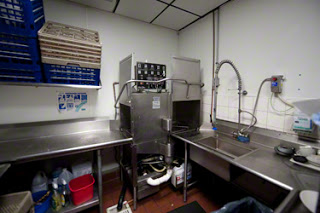Suggestions for Reducing Detergent/Lipid Emulsions:
- Apr 22, 2013
 Keep Soapy flows from Contacting Downstream Fats and Oils (Lipids)
Keep Soapy flows from Contacting Downstream Fats and Oils (Lipids)
A commercial dishwasher’s output is hot, soapy water and is ALWAYS running richer than needed in terms of detergent chemicals. Why? Because it is a far lesser evil to send unused detergent (high in BOD) with sanitizers (chlorides) and water softening agents (a variety of mineral grabbing stuff so as to leave no spots on the washed ware) THAN to have a potential sanitary hazard imposed on the community’s dining customers, i.e. dirty dishes. Sending a commercial dishwasher’s output through the kitchen’s drainage plumbing emulsifies any and all fats or oils in its route, including the retained grease and oils in a conventional downstream grease separator. Notice the wording “conventional”. Anytime a warm (usually no longer hot by that time) soapy flow enters a conventional (think traditional inlet and outlet configuration), it rises “lava lamp” style and displaces the cold water already in the separator. As the cold water layer falls, it tugs on the underside of the trapped grease mat, adding some gentle mixing action.

 Food Equipment and Supplies Magazine recently sent out an E-Newsletter featuring the Trapzilla line of products. Take a moment to check out the articles below and stop by the Trapzilla website to see the award-winning animated short-film.
Food Equipment and Supplies Magazine recently sent out an E-Newsletter featuring the Trapzilla line of products. Take a moment to check out the articles below and stop by the Trapzilla website to see the award-winning animated short-film.